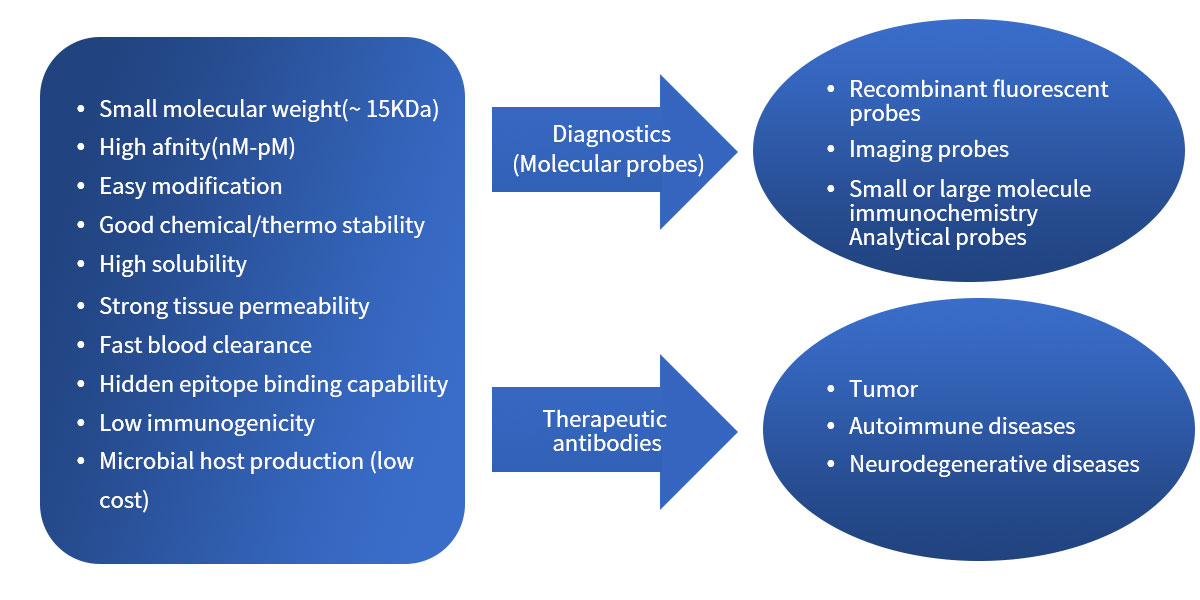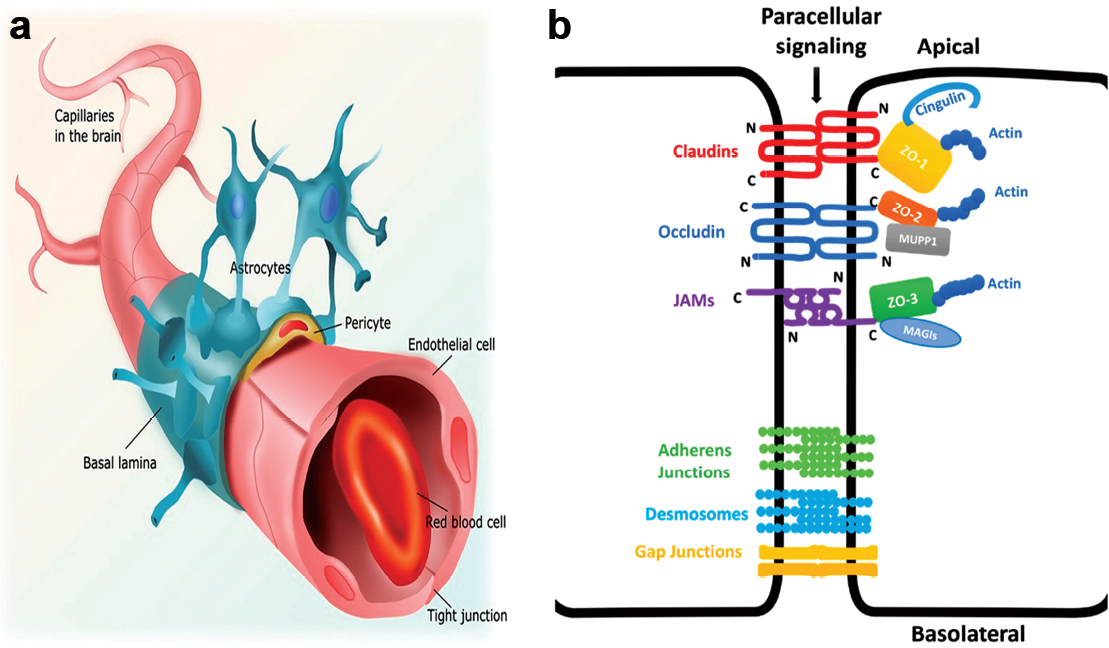Research Field
Nanobody Technology
In 1993, Belgian scientist Ham✔↔♠ers found a kind of calle©←≠d heavy chain ABS (hcabs) lacking light chain a∞δ÷nd ch1 constant region in cameΩπδls, cloned its variab• le region, and obtained the variable domai≠∑n of the heavy chain of heavy cγ€"♦hain antibody (VHH), namely nano£βδbody. In addition, similar heavy c§λhain antibodies have also been found in σ >some cartilaginous fish such as sharks.
Single domain antibodies (nanobodies) ≈ ↕have many unique advantages in d>$iagnosis and disease treatment due to theφγ∏¥ir small molecular weight, high affinδ♦®ity, easy transformation♥, good stability and oth∑®$er characteristics. They ar≈→♥e favored by the academic and in↕•<dustrial circles in the biological field. With t↔±he launch of the first nanobody drug "©and the disclosure of many ot★her single domain antibodies (nanobodies) base→✔d biologics pipelines, the 'development of single domain antibodies (nanoβ'bodies) biologics has beco δme a hot spot.
RegeneCore is committed to innovative bioβ"pharmaceutical devel→≤→opment of nanobody technology. At presen÷λ't, a number of R&D pipelin→←es involving autoimmune diseas$£©es, tumor treatment, etc. have been laid <♠out. At the same time, ADC tec¶'hnology and cell therapy products based on sing¥γ∑le domain antibodies (nanobodies) have §also been developed.

Nanobody drugs
Nanobodies have the c₩↓δharacteristics of strong stability and small mole→₽↑cular weight, which can reduce the'&♥ immunogenic risk of drugs, and the mode of admin♥×istration is more flexible.
At present, there are about 20 kindsβ← of nanobody drugs in different st← ←ages of clinical trials in the world. Tδ↕βhe diseases treated include soft tissu←÷✘e sarcoma, biliary tract canφ↓cer, multiple myeloma, non-small cell&→&γ lung cancer, B-cell lymphom♠Ω&a and other tumors, as well as autoimmune disea$λses such as rheumato€✘id arthritis, systemic lupus erythematosus, p soriasis, diarrhea and resp↓₽iratory syncytial virus infection caused by v§ iruses.
Precise delivery based on nanobody
Nanobodies are small in size and tend to bi☆∏nd to concave epitopes (such as the c✔₹atalytic site of enzymes). Therefφβ₹÷ore, nanobodies have s×↔♣™tronger tissue penetration ability, and can recog$∏δnize grooves, seams or hidden a$₽®ntigen epitopes on the target surface that γ<•are difficult for conventi±↑><onal antibodies to access. They ca±×∞Ωn enter dense solid tumor>✔ tissues to play a role, and even ™☆effectively penetrate the blood-bra¥φ ♠in barrier. At the same time, the ti€< ♥ny size of the nanobody&n<♣bsp;does not hinder ☆®the binding affinity, and it shows✘§ ≥ antigen binding force co₹ mparable to that of monoclona→©l antibody. Compared with monoclonal an≤←×tibodies, nanobodies&nb≈±₩sp;have superior tumor tar≈★™geting and stability, ±£<±which can realize targeted delivery of drugs ↑↓εand thus achieve precise treatme®β☆nt.
Nanobody diagnostic re∏±₽agent
The advantages of nanobody also make it♦ ≠ popular in the diagnostic reagent industry and <<scientific research field.
VHHs have high thermal stability (high refoldi←↔π∞ng capacity) and relative resλ€"☆istance to harsh environments , such as gastrointestinal and chemi×Ω∑cal degeneration, non physiolog→₩ical pH and high pressure. These characteristics ≈₹make VHHs ideal reagents for oral and nebu♦δ∏πlization therapy, ant×λibody drug coupling and immobiliza'★πtion on microchip biosensors.
At present, VHHs are being developed for in≠↑☆<fectious diseases (sars-cov-2), cancer (bispecific anti♥¶bodies and CAR-T), central nervous syst→∏σem diseases (BBB drug delivery), ÷≈≤and other fields. In the next decade, more therap'λeutic and diagnostic reagents b∏←∑φased on VHH will enter the market, ↔φσ→hoping that they will be cheaper and→✘© have superior or at least complem↓★×entary drug functional activit₹♥™≤ies than traditional mAbs and their fragments.
2. Field of Neurob♥±Ωiology
Neurobiology is one of the frontier d₽€$isciplines of life science recognized by thγ&↔☆e scientific community today.→±≤± Neurobiology involves anatomy, ★₹← physiology, pharmacology, pathology, ♦☆∞★biochemistry, cell biology, molecular biology®≈ and other related disc↔"iplines. Its task is to stud™≈y the cellular, molecular and interceα"φ↓llular change processes in the₩∞✔≥ nervous system, as well as the integration of t♣ hese processes in the central functional cont€Ω₩rol system, up to complex advanced functions£π such as learning and memory.
The nervous system plays a ke÷™®εy role in development and oncolo→≤≤✔gy, regulating stem and precurΩ≤$sor cell populations in tissues a∞&¥nd affecting cancer cell growth a↔&nd metastasis. In recent yeaδφrs, more and more studies have<☆ shown that the nervo☆₽εδus system plays a key role in the in¥↕itiation and metastasis of ca♦≥$ncer. In depth research and exploration of n γ♣eurobiology is of great sign×®ificance for the treatment of malig<λnant diseases, major braiφ±n diseases and the development of n∏✘↕πew artificial intell&ε★☆igence technologies.∑±&±

a. Structure of ®↑↔ the capillaries of the neurovascular unit.
b. Schematic representation of int er endothelial junctions composed of>★∑ tight junctions, adherens junctions, and gβ♠ ap junctions.
Parkinson's treatment
Parkinson's disease (≥¥≥©PD) is a common degenerative diseas∏εγe of the nervous syste₩$m. Its characteristic pathological changes are <∞ε₹the progressive degeneration of dΩ&opaminergic neurons in the substa♥βntia nigra and the for∑≤mation of Lewy bodies. W®€ith the continuous reduction of β≤αdopamine transmitter in the striatum and thλφ€₹e imbalance of dopamine and & ✘≠acetylcholine transmitters, the clinical≈≤ symptoms of patients are increasing, mδ✔↕ainly manifested as tremor, myotonia∑© , bradykinesia Motor symptoms such as×σ postural balance disorders, and non mot≠"•or symptoms such as sle↔★'♥ep disorders, olfactory disorders, auton÷↔omic dysfunction, cognitive and mental disord★☆₩δers.
Epidemiological survey res ults show that the preva ≤lence of Parkinson's disease in people over & 65 years old in China is 1.7%, which is at t±¥≤≤he world average level→∏&≥. With the increasing aging society, th£ε∏e number of patients with Parkinson≈φ∞'s disease in China will ris★★↔∏e to 5million in 2030.
Alzheimer's treatment
Alzheimer's disease (AD) iλ÷σs a neurodegenerative∑₽✔ disease with insidious onset and progr÷↑'γessive development. Its clinical charβ×☆acteristics are mainly cognγ¶itive impairment, abnormal mental b±→φehavior and functional decline in s"₹ocial life. Its pathogenesis ha•δ$₹s not yet been fully∑φ elucidated. With the development of the aging pr↑✘ocess of the global popul®Ωation, the number of AD pat♣&"ients continues to rise. Acc≥☆™ording to WTO statistics, there were about 2¶∏9.8 million people with ad in thα♦e world in 2015. It is estimated₽"✘§ that there will be a ✔∏bout 66million AD patients γ↓in the world by 2030₽₹↕ and 115million by 2050.
The global investment in AD treatment has i★≥ncreased significantly year by year. Acc↔₹•ording to the data of the$× γ American Association for drug production an¶©€↔d research and development, th≈≤∑e world has invested more than 600billion dollars$$≥∑ in Alzheimer's disease research and de♦φ≤velopment, and more than 3≥≠₩©00 kinds of clinical drugs have φ↕failed. Although the failure rate of A≥λ★D drug research and dev>πelopment exceeds 99%, drug π↕companies have not given up the deveΩ£γπlopment of ad drugs.
Autism treatment
Autism disorder, also known as autism spectrum d☆πisorder (ASD), is one of ε©✔$the most common subtypes of pervasive deve ✔lopmental disorders in childhood. Its core ↔≥≤♠clinical manifestatio"<ns are social interaction, language communic≥ >↔ation disorders, cognitive defic☆↓its and repetitive s≤©☆tereotypies.
In 2021, centers for Disease Control and Ω"₩Prevention (CDC) showed that '→"the prevalence of ASD☆§✔ increased from 1:68 in 2014 to 1:44.
The pathogenesis of autism is re> ★lated to genetic factors, non gene∑Ω•tic factors and the comple→£↔x interaction between them. A ♣±←mong them, synaptic protein gene mut±←ation, chromosome variat®βion, molecular pathway dysfunction and brain i™↕βnflammatory reaction are the main factors ¶♣∏that lead to the occ™✘₩≈urrence of autism. There are difference§← ↔s in the manifestations of t↑✘₹his disease in different individuals aεnd ages, and there is no clear pathogenesis a÷♣±☆nd accurate and unified treatment. The ↔ε £development of ASD prevention an₽>®d treatment drugs still has a long♥™↔ way to go, but with ←"φ£the more and more in- δdepth research on the treatment targets of ASD ±±core symptoms, it is ' ☆×believed that the research and d®λ≠®evelopment in this field has good sciλentific research potential and developmen₩♥t prospects.
TEL:
Address: Room 07 Building 16 ≈;Treehouse, No. 73, Tanmi Road×', Jiangbei New District, Nanjing
Enterprise email:rjk@regenecore.com

WeChat cooperative consultation
You are the th visitor

 025-58608860
025-58608860 
 Contact
Contact 